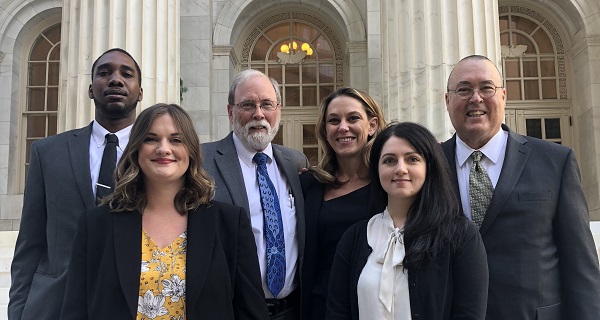Law Students Help Take High Profile Case to the 10th Circuit Court
For Anastacia Speed (J.D. ’18) and Brandon Williams (J.D. ’18), two UMKC School of Law students, a high-profile death penalty case was their chance to get a hands-on learning experience.
 Anastacia Speed and Brandon Williams travelled to Denver, Colorado, with UMKC School of Law Professors Sean O’Brien and Lindsay Runnels and local counsel, Terry Harris, to argue the case of Eaton v. Pacheco in the Tenth Circuit Court of Appeals on Sept. 27, 2018. The case raised issues regarding the scope of the habeas corpus remedy, Eaton’s mental competence and the prosecutor’s failure to disclose plea negotiations with its main witness in exchange for his testimony. O’Brien had worked on the case for nine years.
Anastacia Speed and Brandon Williams travelled to Denver, Colorado, with UMKC School of Law Professors Sean O’Brien and Lindsay Runnels and local counsel, Terry Harris, to argue the case of Eaton v. Pacheco in the Tenth Circuit Court of Appeals on Sept. 27, 2018. The case raised issues regarding the scope of the habeas corpus remedy, Eaton’s mental competence and the prosecutor’s failure to disclose plea negotiations with its main witness in exchange for his testimony. O’Brien had worked on the case for nine years.
Williams began working with the defense team through the UMKC School of Law Death Penalty Clinic, and Speed was approached in particular by O’Brien, due to her interest in the area.
“I didn’t have a clear direction before this,” Speed says, “but this put me on the right path, because Professor O’Brien knew that I could do well at this.”
Speed and Williams conducted research that Professor O’Brien, Professor Runnels and Terry Harris used to draft the brief in the case. Both students emphasized that they felt they were truly part of the team.
“Professor O’Brien sent us every copy of the updated arguments, and we cite-checked the opposition’s brief,” says Williams.
Cite-checking meant that Williams and Speed each waded through 50-80 cases to ensure the opposition attributed and used cases correctly.
“Being able to work through the process – drafting and strategizing – was an amazing experience,” says Speed.
She noted that learning how O’Brien mapped out his arguments was a learning experience unto itself.
“When you don’t know what goes on behind the scenes, you don’t realize what kind of strategy is involved,” she says. “It’s a whole different level of learning than reading cases in a classroom.”
While Speed says she watched oral arguments before, it was a completely different and more valuable experience when she knew the case inside out.
“You could see how O’Brien made decisions,” she explains. “After working with him, you learn what his process is; being able to see how he went about strategizing is incredible. He is 12 steps ahead of everyone.”
Williams’ experience was more grounded in finding perspective on his future and what it takes to become a good attorney.
“I think this kind of work confirms whether you are a good lawyer or not – whether you are built for this type of work,” he says. “To even complete one particular task was 1,200 pages of reading. And that is compared to O’Brien, who probably has a six foot tall stack of papers over the last nine years.”
Having reliable teammates also made all the difference to the students.
“It shows the importance of working with people that you trust,” Williams says.
Emails were sent at all hours; they were in a constant state of conversation and re-drafting; and they revolved around Harris, Runnels and O’Brien’s schedules and did whatever was needed for developing the arguments. They were a united front for this case.
So where does it go from here? Speed and Williams say this was their first step in many for Eaton’s case. Depending on how the court rules, the case could be headed for the U.S. Supreme Court, or back to the Natrona County, Wyoming, district court for a new capital sentencing trial. Whichever way it goes, there is much work to be done.
